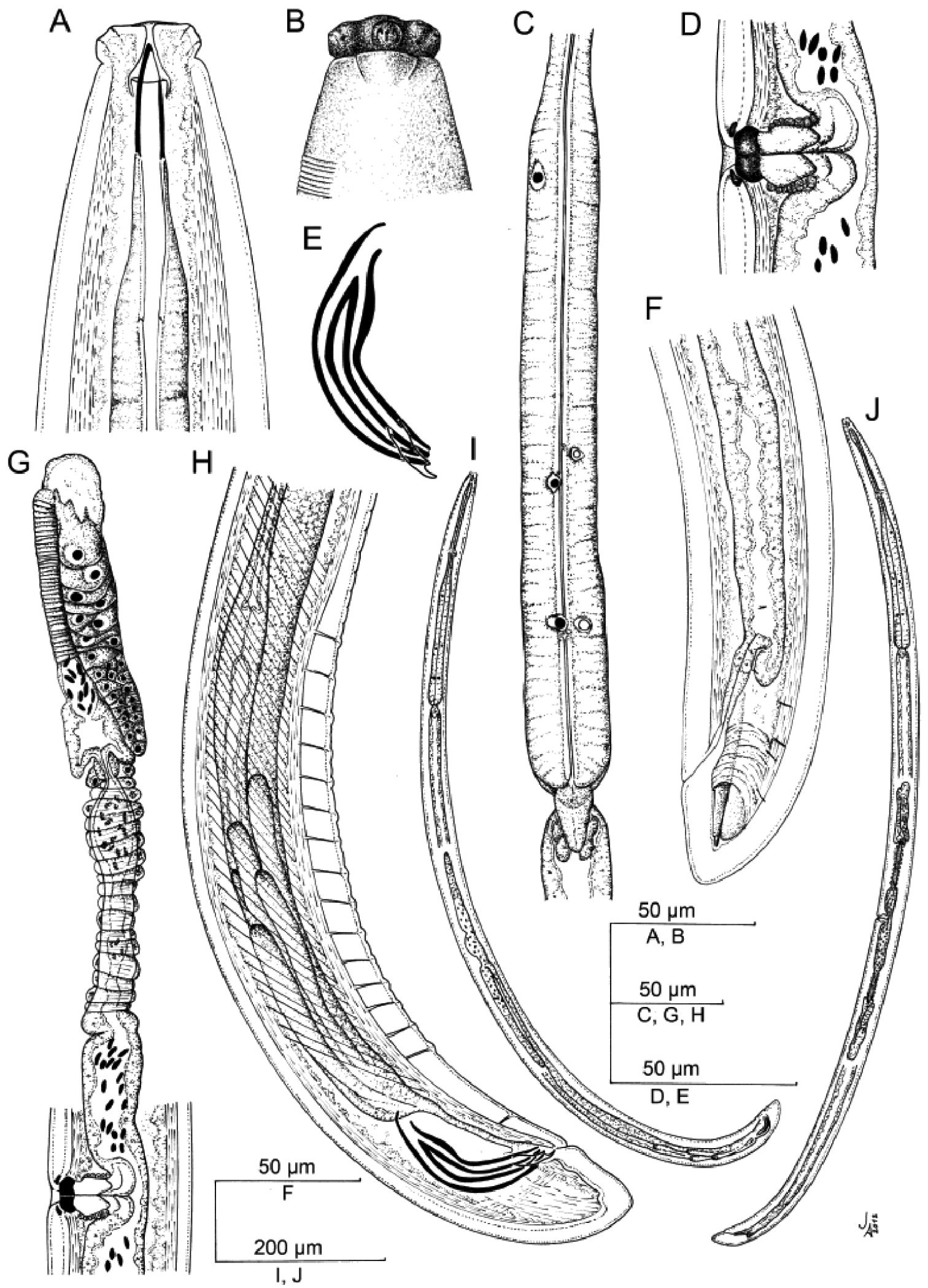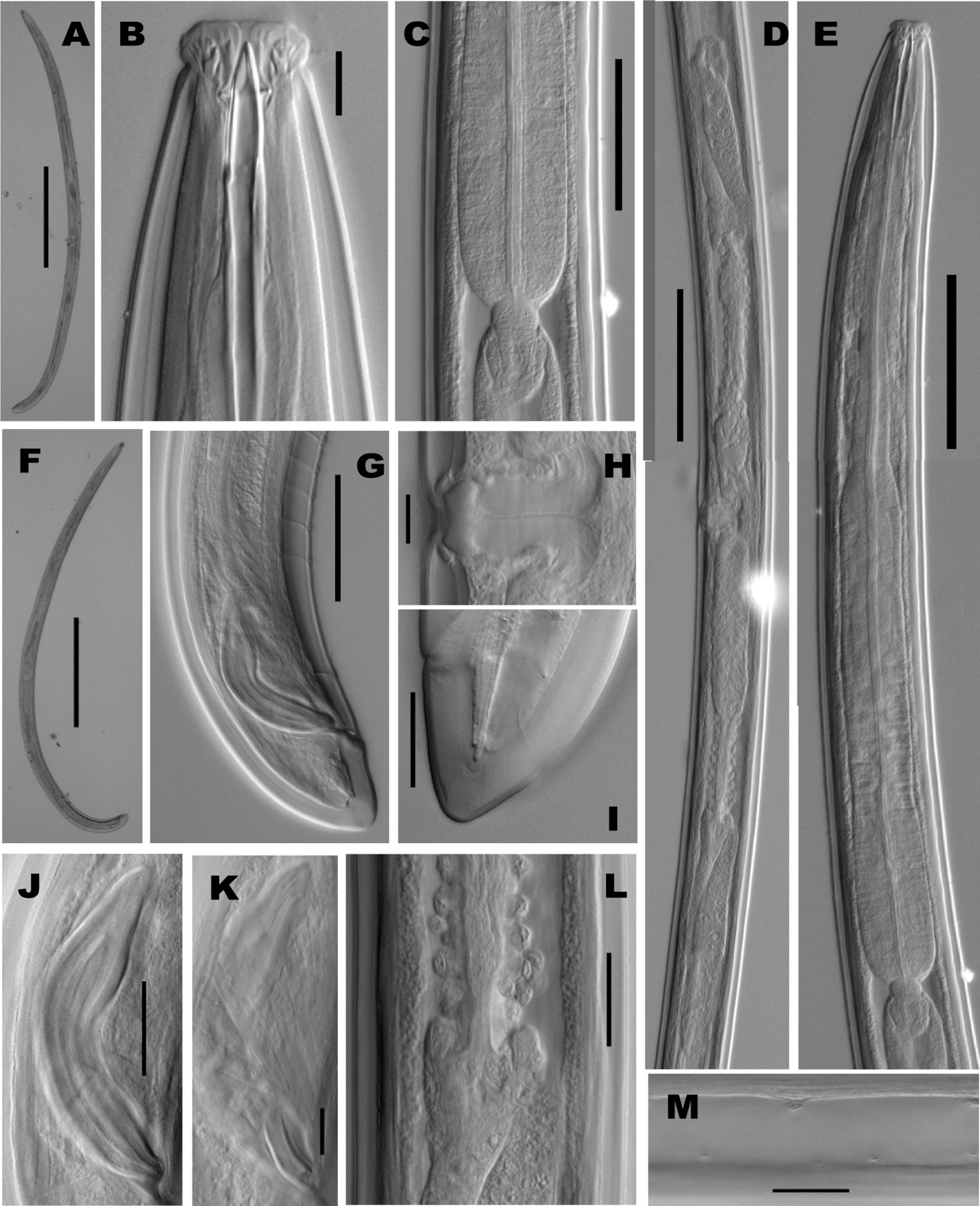






(C) 2012 Habibeh Jabbari. This is an open access article distributed under the terms of the Creative Commons Attribution License 3.0 (CC-BY), which permits unrestricted use, distribution, and reproduction in any medium, provided the original author and source are credited.
For reference, use of the paginated PDF or printed version of this article is recommended.
A new species of the genus Crassolabium, Crassolabium persicum sp. n., collected from Arasbaran rangelands of Iran, is described and illustrated. It is characterized by its body 1.92–2.40 mm long, lip region offset by constriction and 17–19 μm wide, odontostyle 16–19 μm long with aperture occupying less than one–third (27–30%) its length, neck 428–690 μm long, pharyngeal expansion 369–390 μm long or occupying 54–56% of total neck length, female genital system amphidelphic, uterus bipartite and 162–218 μm long or 2.3–3.5 times as long as body diameter, pars refringens vaginae well developed, V = 54–57.5, vulva longitudinal, prerectum bearing a blind sac, tail conical with rounded tip to conoid (25–36 μm, c=60–69, c’=0.5–0.9), spicules 68–72 μm long, precloacal pair of supplements far (22–27 μm) from cloacal aperture, and 13–17 shortly spaced ventromedian supplements with hiatus. The new taxon is compared in depth to its relatives in Crassolabium as well as other similar species of Aporcelaimellus and Amblydorylaimus.
Crassolabium, description, Dorylaimida, Iran, morphology, nematodes, new species, taxonomy
The genus Crassolabium Yeates, 1967 (syn. Thonus Thorne, 1974) is a highly diverse and worldwide distributed dorylaimid taxon. According to the recent compendium provided by
The dorylaimid fauna of Iran has not traditionally received much attention. This situation has significantly changed during recent years, when a series of contributions – see, for instance,
During a general nematological survey in natural and cultivated areas, a few female and male specimens belonging to this genus were collected. Its study revealed this material belongs to a non-described and interesting species, which is the matter of this contribution.
Material and methodsSoil samples were collected from Mahmood Abad, Arasbaran rangelands, northwest Iran, during 2009–2010. The nematodes were extracted by a modified combined sieving and centrifugation flotation method (
urn:lsid:zoobank.org:act:E8DCBD3A-1F12-4390-98C4-F2AFCA0A1CF9
http://species-id.net/wiki/Crassolabium_persicum
Figures 1, 2Five females and four males, in excellent state of preservation.
See Table 1.
Morphometric data of Crassolabium persicum sp. n. Measurements in μm except L in mm, and in the form: mean ± standard deviation (range).
| Holotype | Paratypes | Paratypes | |
|---|---|---|---|
| Character n | ♀ | 5♀♀ | 4♂♂ |
| L | 2.33 | 2.22±0.19 (1.92–2.40) | 2.24±0.09 (2.13–2.34) |
| a | 34 | 31.9±1.4 (30–34) | 34.2±2.4 (32–38) |
| b | 3.5 | 4.0±0.36 (3.5–4.2) | 4.0±0.4 (3.7–4.7) |
| c | 68 | 64.8±3.5 (60–69) | 69.5±3.1 (63–72) |
| c’ | 0.7 | 0.74±0.14 (0.5–0.9) | 0.75±0.09 (0.6–0.8) |
| V | 57 | 57±1.75 (54–57.5) | – |
| Lip region diameter | 17.5 | 17.8±0.6 (17–19) | 18.2±2.5 (17–19) |
| Odontostyle length | 19 | 17.5±0.9 (16–19) | 18.6±1.2 (18–20) |
| Odontophore length | 27.5 | 28.5±1.4 (26–31) | 28.6±1.9 (27–31) |
| Guiding ring – anterior end | 10 | 11.0±1.3 (10–12) | 11.2±0.5 (11–12) |
| Neck length | 690 | 428–690 | 542–569 |
| Pharyngeal expansion length | 380 | 369–390 | 308–315 |
| Body diameter at neck base | 65 | 68±2.1 (58–71) | 62.6±7.6 (57–64) |
| mid–body | 69 | 69.5±3.5 (63–74) | 65.5±4.0 (61–69) |
| anus/cloaca | 43 | 42.2±2.0 (38–44) | 40.1±1.8 (39–43) |
| Rectum length | 34 | 35.1±6.5 (29–40) | 35.0±0.9 (34–36) |
| Prerectum length | 68 | 67.5±11.5 (57–102) | 70±9.0 (62–112) |
| Tail length | 33 | 34.3±2.5 (25–36) | 31.6±4.6 (25–35) |
| Spicules length | – | – | 70.1±1.3 (68–72) |
| Ventromedian supplements | – | – | (13–17) |
Adult. Slender nematodes of medium size, 1.92–2.40 mm long. Body cylindrical, slightly tapering towards both ends. Habitus more or less curved ventrad upon fixation, adopting an open ‘C’ shape. Cuticle dorylaimoid, with very fine transverse striation, sometimes difficult to distinguish; 3.5–5.0 μm thick in anterior region, 5.5–8.0 μm at mid–body and 8–13 μm on tail. Lateral chord 10–18 μm wide at mid–body, occupying 15–30% of mid–body diameter; lateral pores readily visible, arranged in two rows along both margins of lateral chord. Lip region truncate, somewhat angular, offset by marked constriction, 3.0–4.0 times as broad as high and 25–36% of body diameter at neck base; lips moderately separated; labial and cephalic papillae protruding. Amphid fovea funnel–like, its opening occupying 10–11 μm or three–fifths (60%) of lip region diameter. Odontostyle quite robust, wider than adjacent cuticle, 4–6 times as long as wide, 1.0–1.1 times the lip region diameter and 0.8–1.1% of body length; aperture occupying less than one–third (27–30%) its length. Guiding ring simple but distinct, at 10–12 μm or 0.5–0.7 times the lip region diameter from anterior end. Odontophore rod–like, lacking any differentiation, 1.1–1.4 times the odontostyle length. Pharynx consisting of a slender but muscular anterior portion enlarging gradually; basal expansion 9–11 times as long as broad, 5.3–6.0 times longer than body diameter at neck base, and occupying more than half (54–56%) of total neck length; pharyngeal gland nuclei situated as follows: DO = 46–50%, DN = 48–53%, S1N1 = 72–76%, S1N2 = 76–81%, S2N = 87–90%. Of note, S1N are significantly smaller than S2N. Nerve ring located at 155–187 μm or 32–41% of total neck length. Cardia tongue–like, 12–19 x 11–16 μm and surrounded by intestinal wall.
Female. Genital system didelphic-amphidelphic, with both branches well and equally developed, the anterior 364–476 μm long or 15–18% of total body length, and the posterior 358–395 μm long or 14–16% of total body length. Ovaries reflexed, moderately developed, sometimes reaching and surpassing the sphincter level; the anterior 114–131 μm, the posterior 101–127 μm long; oocytes arranged distally in several rows and then proximally in a single row. Oviduct joining ovary, 88–130 μm long or 1.3–1.8 body diameters and consisting of a tubular part and a moderately developed pars dilatata with small lumen. Oviduct-uterus junction marked by a distinct sphincter. Uterus 162–218 μm long or 2.3–3.5 times the corresponding body diameter, bipartite, i.e., consisting of two sections with variable length: a wider proximal region with distinct lumen containing abundant sperm cells, and a distal part with narrow lumen and globular walls surrounded by circular muscles. Vagina extending inwards 32–45 μm or less than half (36–44%) of the corresponding body diameter; pars proximalis longer than wide, 26–40 × 19–22 μm, with slightly sigmoid walls and surrounded by moderately developed musculature; pars refringens with (in lateral view) two distinct, trapezoidal, closely-spaced pieces, measuring 6–8 × 8–11 μm and with a combined width of 17–21 μm; pars distalis very short, with two small sclerotizations close to the pars refringens. Vulva a post–equatorial longitudinal slit appearing in lateral view as a short longitudinal depression. Prerectum 1.3–2.1 anal body diameters long, with a well developed blind sac. Rectum 0.9–1.3 times the anal body diameter. Tail short, conical with rounded tip to conoid, ventrally nearly straight, dorsally more convex. Two pairs of caudal pores, one subdorsal, other lateral or subventral.
Crassolabium persicum sp. n. (all images are in lateral view) A Anterior region B Lip region and amphid fovea in surface C Pharyngeal expansion D Vagina E Spicules and lateral guiding piece F Female, posterior body region G Female, anterior genital branch H Male, posterior body region I Male, entire J Female, entire.
Crassolabium persicum sp. n. (light micrographs all in lateral view).A Female, entire B Anterior region C Pharyngo–intestinal junction D Female, genital system E Neck region F Male, entire G Male, posterior region H Vagina I Female, caudal region J Spicules K Lateral guiding piece L Oviduct–uterus junction M Lateral chord and pores. (Scale bars: A, F – 500 µm; B, H, K – 10 µm; C, G – 50 µm; D, E – 100 µm; I, J, L, M – 20 µm).
Male. Genital system diorchic, with opposite testes. In addition to the adcloacal pair, situated at 22–27 μm from cloacal aperture, there is a series of 13–17 shortly and regularly spaced (11–16 μm apart) ventromedian supplements, outside the range of spicules; posterior-most ventromedian supplement located at 47–53 μm from adcloacal pair. Spicules strongly curved ventrad and moderately robust, 4.0–5.0 times as long as wide and 1.6–1.7 anal body diameter long. Lateral guiding pieces short and robust, 11–16 μm long, 2.5–4.0 times as long as wide, with bifurcate terminus in which the posterior arm is visibly longer than the anterior one. Prerectum length 1.7–2.3 times the anal body diameter. Tail somewhat more conoid than that of female.
The new species is characterized by body length of 1.92–2.40 mm , lip region offset by constriction and 17–19 μm wide, odontostyle 16–19 μm long with aperture occupying less than one-third (27–30%) its length, neck 428–690 μm long, pharyngeal expansion 369–390 μm long or occupying 54–56% of total neck length, female genital system amphidelphic, uterus bipartite and 162–218 μm long or 2.3–3.5 times as long as body diameter, pars refringens vaginae well developed, V = 54–57.5, vulva longitudinal, prerectum bearing a blind sac, tail conical with rounded tip to conoid (25–36 μm, c = 60–69, c’ = 0.5–0.9), spicules 68–72 μm long, precloacal pair of supplements well far (22–27 μm) from cloacal aperture, and 13–17 shortly spaced ventromedian supplements with hiatus.
The general pattern of this species fits well with that of the genus Crassolabium. It resembles Crassolabium diversum (Ciobanu, Popovici, Abolafia & Peña-Santiago, 2007)
The new species is also comparable to Aporcelaimellus index (Thorne, 1939)
Finally, in the location of the pre-cloacal pair of male genital papillae - comparatively far from cloacal aperture, indeed a very unusual feature in dorylaims -the new species is reminiscent of the genus Amblydorylaimus Andrássy, 1998, with the type and only species Amblydorylaimus isokaryon (Loof, 1975)
The soil samples were collected from Mahmood Abad region (GPS coordinates: 38°48'N, 46°51'E), Arasbaran rangelands, East Azarbaijan province, north-west Iran.
Female holotype, two female paratypes and three male paratypes are deposited in Nematode Collection, Faculty of Agriculture, University of Tabriz, Tabriz, Iran. One female paratype and one male paratype with nematode collection of Departamento de Biología Animal, Biología Vegetal y Ecología, Universidad de Jaén, Spain.
The specific epithet refers to the geographical area where the new species was collected from.
The Spanish authors thank the financial support received from the project Fauna Ibérica (Spanish Ministry of Education and Science, ref. CGL 2007–66786–008–08, co–financed FEDER). The Iranian authors are very grateful to Dr. M. Nikdel for his help in sampling. Open access to this paper was supported by the Encyclopedia of Life (EOL) Open Access Support Project (EOASP).

